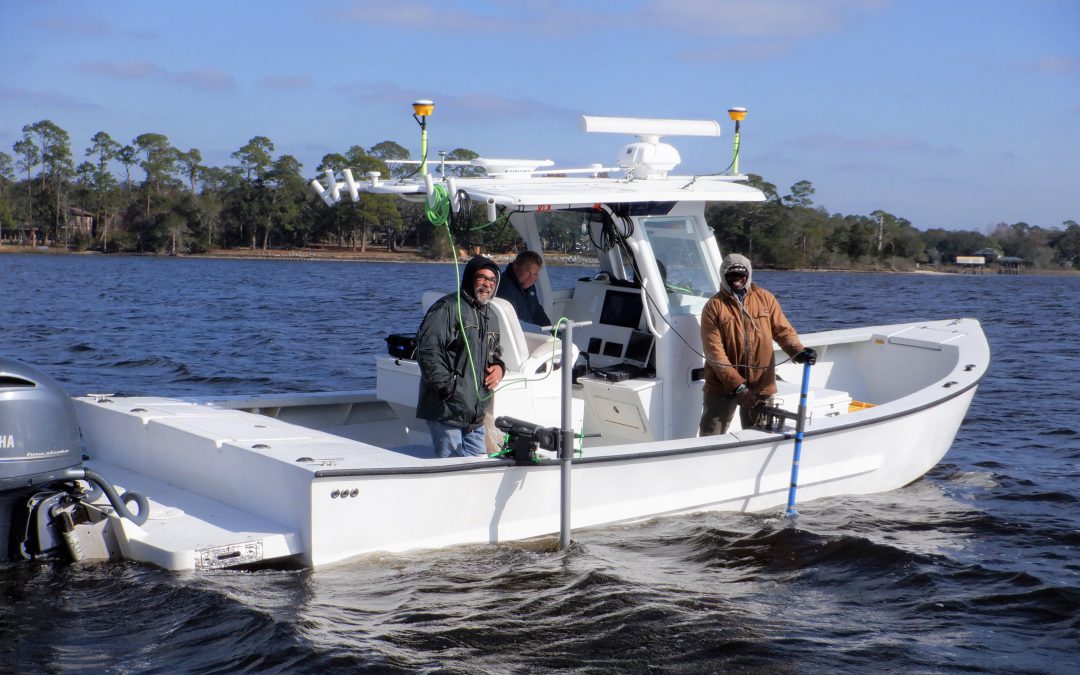
by Chris Verlinde | Jan 22, 2021
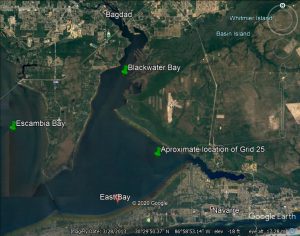
Santa Rosa Portion of the Oyster Mapping and Assessment Project
Santa Rosa County R.E.S.T.O.R.E. has funded the SRC Oyster shell recycling program and the Pensacola, East and Blackwater Bays Intertidal and Subtidal Oyster Reef mapping and Assessment projects. The Nature Conservancy is managing the oyster reef mapping and assessment project and has contracted with MREC Environmental, LLC to get the work done.
The purpose of the project is to map and assess the condition of known and potential intertidal and subtidal oyster reef resources in the Santa Rosa County portion of the Pensacola Bay system. Results of this mapping project will establish a baseline of the existing locations and condition of oyster resources in SRC. This information will help to guide future restoration projects.
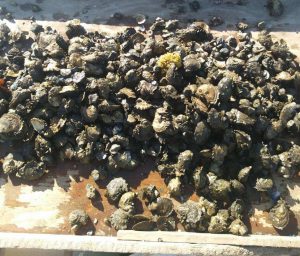
Subtidal oysters are harvested in clumps and are culled using a large knife or hatchet. Photo credit: Calvin Sullivan
Intertidal reefs are typically exposed at low tides and found along the shoreline of our bay system. Sub-tidal reefs are found under water. Gabe Johnson, owner of MREC Environmental has verified existing intertidal reefs using a jet-ski in the fall of 2020. Our bay system does not have as many natural intertidal reefs as in other parts of Florida. There are existing intertidal reefs that have been installed for shoreline protection and habitat enhancement.
Gabe Johnson and the crew of MREC Environmental are working to complete the initial bottom survey in early 2021. He has set up grids based on historic locations of oyster reefs throughout the Santa Rosa County portion of the Pensacola Bay system. He will then verify his findings by diving sites where oyster shell was found during the bottom survey.
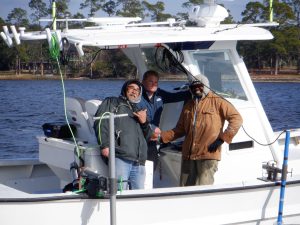
From left to right: Dale, Gabe and Reese of MREC Environmental. Phot credit: Chris Verlinde
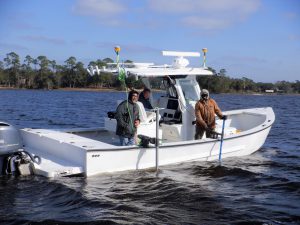
Side scan sonar and echosounder along the side of the boat. Photo Credit: Chris Verlinde
Gabe and his crew are using one Side Scan Sonar, an Edgetech 4125i to map images of the bottom. The other instrument they are using is a Singlebeam Hydrographic Echosounder (Teledyne Odom Echotrac CV100). The echosounder is used to collect water depth data and contours of the water bottom. The echosounder is connected to a transducer. The side scan sonar and the transducer from the ecosounder are placed along the side of the boat and submerged while the boat travels over the transects to collect the underwater images and parameters.
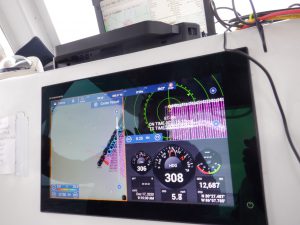
The pink lines are the transect lines of grid #25. Photo credit: Chris Verlinde
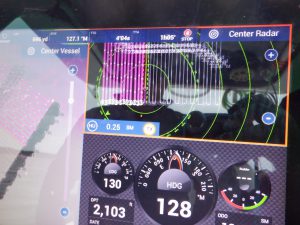
About two thirds of grid #25 are completed. Photo credit: Chris Verlinde
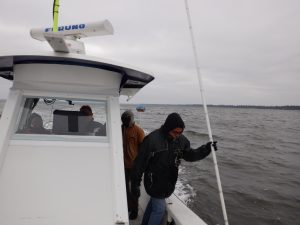
Dale dropping the pole to assess bottom characteristics. Photo credit: Chris Verlinde
On a cold day in December 2020, Gabe and his crew covered 149.3 acres in grid #25, just west of the power lines in East Bay. Grid 25 included 32 parallel transect lines (2468 feet long), spaced 100 feet apart. This grid was completed in approximately three and a half hours by running the boat along each transect and recording data. In addition to the electronic data, one of the crew members used a fiberglass pole to assess bottom conditions. Approximately, every 10 feet or so, the pole guy would lower the pole and shout the condition of the bottom, either sand, mud, or shell. Gabe then recorded the point and code on his mapping software.
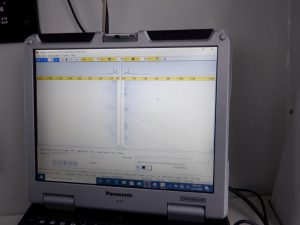
Image from the side scan sonar showing a sand bottom. Photo credit: Chris Verlinde
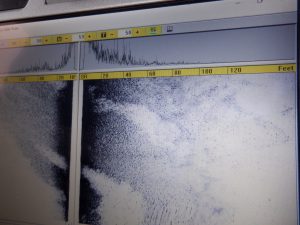
Side scan image of bottom with showing potential shell (the darker scatter area). Photo credit: Chris Verlinde
The raw data will be compiled into maps and a report that will be used to based future oyster fishery and habitat enhancement restoration efforts in East, West and parts of Escambia Bay.
by Brooke Saari | Mar 8, 2013
National Invasive Species Awareness Week: March 3rd – March 8th
March 8th: Red Imported Fire Ant (Solenopsis invicta Buren) & Giant Tiger Prawn (Penaeus monodon):
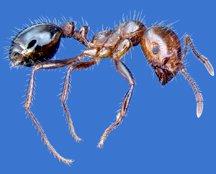
Photo Credit: David Almquist, University of Florida
Red Imported Fire Ant: Many of us cherish childhood memories of family picnics during summer. What we likely also remember are the surprise guests that arrive to take away any crumbs we happen to drop their way. Ants are a common site in almost any yard or farm in Florida. Homeowners and farmers spend time and money trying to rid their landscapes of the pests. Red imported fire ants (RIFA) are a species first introduced into the United States in our local area through the port of Mobile. These ants have now spread to states as far west as California and north to Maryland. Red or brown in body color, they build large nests with soil above the ground. Any disturbance of the mound brings thousands of angry ants to find the intruder. Ants have a short lifecycle and lifespan. Eggs usually hatch in 22-38 days and workers live no longer than 6 months. Queens can live to 6 years, however. RIFA’s forage on dead animals and home food wastes. Garbage and food left around the home can attract ants into dwellings. Mounds are common around or under structures, moving to higher ground during rainy weather. RIFA’s can also damage crops and cause equipment damage with large enough infestations. Management for these pests can be accomplished in two ways: through individual mound treatments or through broadcast treatments. Individual recommendations can be found here, http://edis.ifas.ufl.edu/in352. Whatever method of treatment you choose, make sure to follow proper label recommendations on products. Care should be given to areas where children, pets, and livestock have access to avoid ingestion of treatments chemicals.
For more information, contact the author Allison Meharg, 4-H Livestock & Small Farms Agent 850-475-5230.
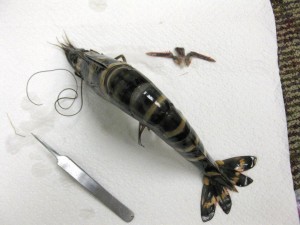
Photo Credit: FWC photo by Michelle Sempsrott
Giant Tiger Prawn: This large shrimp, also known as the Asian Tiger Shrimp and the Black Tiger Shrimp, can reach lengths between 8-12 inches. It resembles are native edible penaeid shrimp but differs in that it has distinct black and yellow stripes. It was brought to the U.S. from the Indo-Pacific region as an aquaculture product. There was an accidental release of 2,000 animals from a South Carolina farm in 1988. Reports of this shrimp in the wild have increased over time. They have been found in all Gulf coast states and there has been at least 1 record in each of the Florida panhandle counties. The impact of this shrimp to our area is still unknown but they have a high tolerance for salinity change and consume many types of benthic invertebrates. It is thought that they could become serious competition for our native penaeid shrimp and could possible transmit diseases. If you think you have found one of these shrimp, record size location (GPS preferred) and email information to ExoticReports@MyFWC.com. To learn more about this species view the USGS factsheet.
For more information, contact the author Rick O’Connor, Sea Grant/Marine Sciences Agent 850-475-5230.












